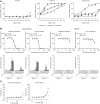TAK-994 mechanistic investigation into drug-induced liver injury
- PMID: 39786842
- PMCID: PMC11939078
- DOI: 10.1093/toxsci/kfaf003
TAK-994 mechanistic investigation into drug-induced liver injury
Abstract
The frequency of drug-induced liver injury (DILI) in clinical trials remains a challenge for drug developers despite advances in human hepatotoxicity models and improvements in reducing liver-related attrition in preclinical species. TAK-994, an oral orexin receptor 2 agonist, was withdrawn from phase II clinical trials due to the appearance of severe DILI. Here, we investigate the likely mechanism of TAK-994 DILI in hepatic cell culture systems examined cytotoxicity, mitochondrial toxicity, impact on drug transporter proteins, and covalent binding. Hepatic liabilities were absent in rat and nonhuman primate safety studies, however, murine studies initiated during clinical trials revealed hepatic single-cell necrosis following cytochrome P450 induction at clinically relevant doses. Hepatic cell culture experiments uncovered wide margins to known mechanisms of intrinsic DILI, including cytotoxicity (>100× Cmax/IC50), mitochondrial toxicity (>100× Cmax/IC50), and bile salt efflux pump inhibition (>20× Css, avg/IC50). A potential covalent binding liability was uncovered with TAK-994 following hepatic metabolism consistent with idiosyncratic DILI and the delayed-onset clinical toxicity. Although idiosyncratic DILI is challenging to detect preclinically, reductions in total daily dose and covalent binding can reduce the covalent body binding burden and, subsequently, the clinical incidence of idiosyncratic DILI.
Keywords: bile salt efflux pump; covalent binding; drug discovery; drug-induced liver injury; hepatotoxicity.
© The Author(s) 2025. Published by Oxford University Press on behalf of the Society of Toxicology.
Figures





References
-
- Bauman JN, Kelly JM, Tripathy S, Zhao SX, Lam WW, Kalgutkar AS, Obach RS. 2009. Can in vitro metabolism-dependent covalent binding data distinguish hepatotoxic from nonhepatotoxic drugs? An analysis using human hepatocytes and liver S-9 fraction. Chem Res Toxicol. 22:332–340. - PubMed
-
- Chemelli RM, Willie JT, Sinton CM, Elmquist JK, Scammell T, Lee C, Richardson JA, Williams SC, Xiong Y, Kisanuki Y, et al. 1999. Narcolepsy in orexin knockout mice: molecular genetics of sleep regulation. Cell. 98:437–451. - PubMed
-
- Chen M, Borlak J, Tong W. 2016. A model to predict severity of drug-induced liver injury in humans. Hepatology. 64:931–940. - PubMed
-
- Cho T, Uetrecht J. 2017. How reactive metabolites induce an immune response that sometimes leads to an idiosyncratic drug reaction. Chem Res Toxicol. 30:295–314. - PubMed
MeSH terms
Grants and funding
LinkOut - more resources
Full Text Sources
Medical
Miscellaneous

